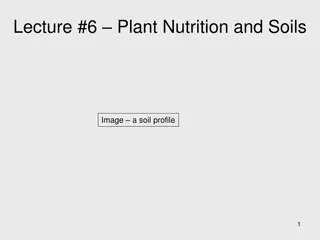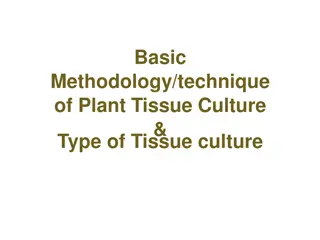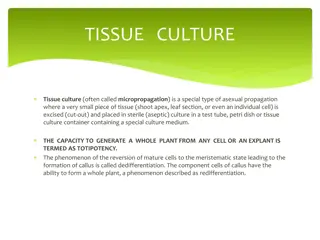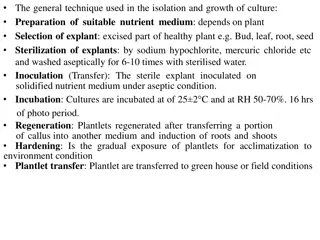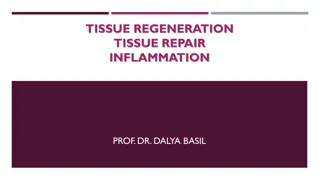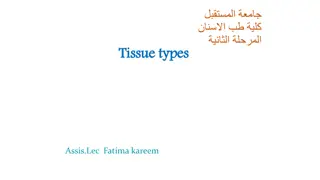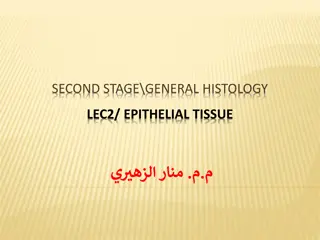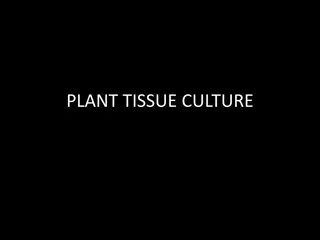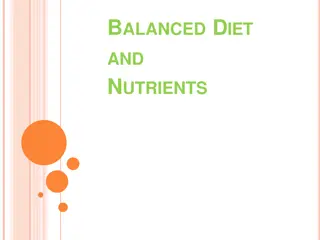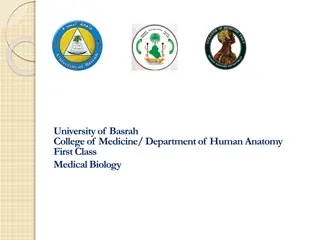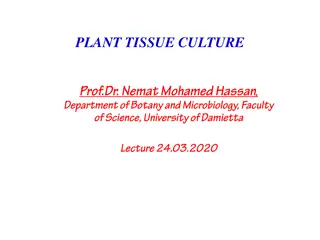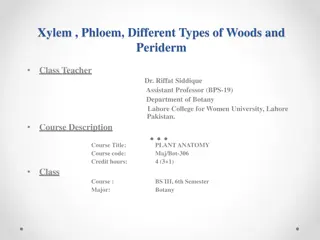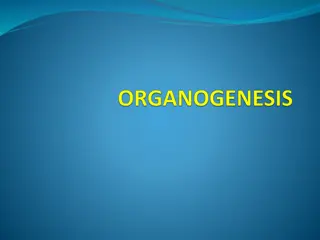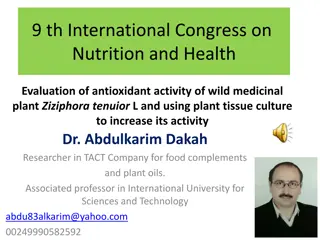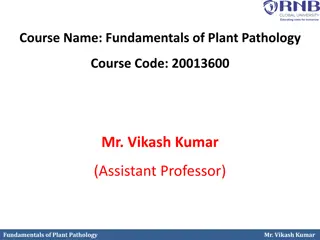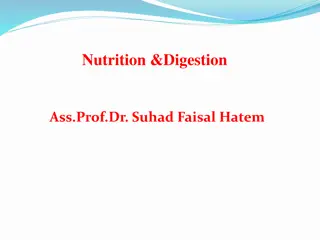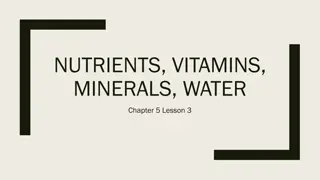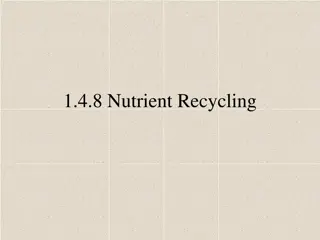Essential Nutrients for Plant Tissue Cultures: A Comprehensive Guide
The composition of culture media for plant tissue cultures includes inorganic and organic nutrients, sources of energy like sucrose and amino acids, and essential macro and micronutrients. Providing gas exchange, waste removal, and growth regulators, the medium supports plant growth by offering access to vital elements and maintaining optimal conditions. Inorganic macro and micro nutrients, along with organic components like vitamins and growth hormones, play crucial roles in the growth and development of plant tissues in culture.
Download Presentation

Please find below an Image/Link to download the presentation.
The content on the website is provided AS IS for your information and personal use only. It may not be sold, licensed, or shared on other websites without obtaining consent from the author. Download presentation by click this link. If you encounter any issues during the download, it is possible that the publisher has removed the file from their server.
E N D
Presentation Transcript
Nutrient Media for Plant Tissue Cultures
Functions of medium Provide Provide Provide Provide Access to atmosphere for gas exchange Removal of plant metabolite waste water mineral nutritional vitamins growth regulators needs
Sources of energy Carbon Source Nitrogen Source - - - - - Sucrose 2-5% Fructose Lactose Maltose Starch Defined Undefined - Milk of cocunut -Extracts of malt yeast & corn Major Inorganic - NH4+ - NO3- Minor ions - Amino acids - Glycine - Glutamine 83
Composition of Culture media Cultre Media is composed of Inorganic nutrients which includes macronutrients like nitrogen, phosphorous, potassium, calcium etc. and micronutrients like boron, copper, iron, manganese, zinc etc. Organic nutrients includes Vitamins like Vitamin B1, B6, B3, B5 etc. Amino acids like L-arginine, L-asparagine, L-cysteine HCL, L-glutamine etc, Carbon source like glucose or maltose, Growth hormones/regulators like auxin, cytokinins and gibberellins, ethylene,abscisic acid. Others media substances like protein hydrolysates, yeast extaracts, fruit (e.g. banana) extracts, coconut milk, solidifying agents like agar, alginate, gelatin etc., Iron source e.g.EDTA, Antibiotics. pH of the medium should be in a range of 5.6-6.0 before autoclaving the culture medium
Inorganic Macro nutrients for plant tissue cultures Constituents Heller Nitsch & Nitsch White Hildebrand t Ricker & Dugger Musashige & Skoog Gautheret KCl 750 1500 65 65 NaNO3 600 250 250 720 180 370 125 MgSO47H20 125 250 16.5 33 NaH2PO4H20 75 440 CaCl22H20 KNO3 2000 80 80 1900 125 CaCl2 25 Na2SO4 200 800 Ca(NO3)2 NH4NO3 1650 KH2PO4 170 125 MgSO4 300 400 500 Ca(No3)24H20 85
Inorganic Micro nutrients for plant tissue cultures Constituents Heller Nitsch & Nitsch White Hildebrandt Ricker & Dugger Musashige & Skoog Gautheret NiSO4 0.05 27.8 0.05 FeSO47H20 MnSO44H20 KI 0.01 3 7 4.5 22.3 3 0.01 0.75 3.0 0.83 0.5 0.03 NiCl26H20 CoCl2 Ti(SO4)3 ZnSO47H20 CuSO45H20 BeSO4 H3BO3 H2SO4 FeCl36H20 Mg2MO4 AlCl3 Fe2(SO4)3 Ferrictartarate 0.025 0.2 0.01 0.5 3 6 8.6 0.18 0.03 0.025 0.025 0.05 0.1 1.0 0.5 1.5 0.38 6.2 0.05 1.0 1.0 0.025 0.25 0.03 2.5 40 6 8
Inorganic nutrients: Mineral elements play very important role in the growth of plant Function of nutrients in plant growth. Essentially about 15 elements found important for whole also been proved necessary for the growth of tissue(s) in culture. Macronutrient: Elements required than 0.5 mmol/lit are referred as macronutrients. The macronutirents include six major elements as follows: Nitrogen (N), Potassium (K), Phosphorous (P), Calcium (Ca), Magnesium (Mg), Sulfur (S). Nitrogen 2-20mmol/lit Influences plant growth rate, essential in plant nucleic acids (DNA), proteins, chlorophyll, amino acids, and hormones. plant growth have in the life of a plant greater
Phosphorus 1-3 mmol/lit Abundant in meristimatic and fast growing tissue, essential respiration. in photosynthesis, Potassium 20 meristematic carbohydrate, protein and chlorophyll synthesis. -30 mmol/lit Necessary for cell division, tissue, helps in the pathways for Calcium 1-3 mmol/lit - Involved in formation of cell walls and root and leaf development. translocation of sugars, amino acids, and ties up oxalic acid (toxin) Participates in Magnesium 1-3 mmol/lit - Involved in photosynthetic and respiration system. Active in uptake of phosphate and translocation of phosphate and starches. Sulfur 1-3 mmol/lit - Involved in formation of nodules and chlorophyll synthesis, structural component of
Inorganic nutrients: contd Micronutrient: Elements required in the life of a plant less than 0.5 mmol/lit are referred as micronutrients. Overall the plant thrives on seventeen elements out of which four like carbon, hydrogen, oxygen and nitrogen are derived from the atmosphere microelements like Boron, copper, iron, manganese, zinc, cobalt, molybdenum, nickel, aluminium, iodine, ferrous, sodium, chlorine. A media lacking in these micronutrient does not healthy and wholesome growth and the plant deficiency vessels, presence of narrow hypertrophy and symptoms of chlorosis due to absence of ferrous and sulphur. and the rest thirteen support exhibits symptoms such as pigmentation, absence of cambial zone, cellular
Micronutrients concentrations and there role (Fe)-1 mM/l - chlorophyll synthesis and photosynthesis. Eg. sodium salt of EDTA. Manganese (Mn) 20-90 mM/l - Involved in Cell elongation regulation of enzymes and growth hormones. Assists in photosynthesis and respiration Involved in Cell division,respiration, Iron FeNaEDTA . Boron (B) 2-5100 mM/l responsible elongation Copper (Cu) 0.1 mM/l Molybdenum (Mo) 5mM/l Cobalt (Co) 0.1 mM/l Zinc (Zn) 1.5-30 mM/l Iodine (I) Nickel (Ni), Aluminum (Al), Ferrous, chlorine and sodium (Na) are also required for cell division and cell
Organic nutrients It includes Nitrogen substances, Vitamins, Amino acids, Carbon source, Growth hormones/regulators Nitrogen source Most cultured plant cells are capable of synthesising essential vitamins but not in sufficient amount. To achieve best growth it is essential to supplement the tissue culture medium with one or more vitamins and amino acid. Vitamins Thiamine (Vitamin B1) - essential as a coenzyme in the citric acid cycle. It is required mostly in tissue culture and is considered to be essential. Thiamine hydrocholoride in 0.1- 1mg/lit concentration is required. Nicotinic acid (niacin-Vitamin B3) 0.5 mg/lit, Pyridoxine (Vitamin B6) 0.5 mg/lit, Calcium pentothenate (Vitamin B5) 0.1 mg/lit, are known to improve growth of the tissue culture material. Myo-inositol - part of the B complex, in phosphate form is part of cell membranes, organelles and is not essential to growth but beneficial and have important role in many biosynthetic pathways. Cynocobalamin (Vitamin B12), Riboflavin (Vitamin B1,), Folic acid (Vitamin M) 0.5 mg/lit, Biotin (Vitamin H), p-amino benzoic acid (PABA), Ascorbic acid (Vitamin C), - tocopherol (vitamin E) are added in special cases but their exact role is not yet well established.
AminoAcids Some cultured plant-cells can synthesize all amino acids, none are considered essential. The most common sources of organic nitrogen used in culture media are amino acid mixtures, (e.g., casein hydrolysate), L-glutamine, L- asparagine, orginine, methionine and adenine. When amino acids are added alone, they can be inhibitory to cell growth. Tyrosine has been used to stimulate morphogenesis in cell cultures but should only be used in an agar medium. L-tyrosine - stimulates shoot formation. Supplementation of the culture medium with adenine sulfate can stimulate cell growth and greatly enhance shoot formation. Carbon source Carbohydrates are used in tissue culture media as an energy source of carbon. Most plant tissue culture are nonautotropic and are therefore entirely dependent on an external source of carbon. The most commonly used carbon source is Sucrose (2-5% or 20-30 g/lit) Glucose and Fructose are used for good growth.
Maltose and raffinose are used in some cases. In general excised dicotyledonous roots grow better with sucrose where as monocots do best with dextrose (glucose). Other carbohydrates like mannose, sorbitol, pentoses, sugar alcohol, glycols, hexoses, uronic acid, lactose, galactose, potato starch, grain starch and even glycosides can be used depending on the experimental conditions. Growth hormones/regulators/ Modulators The success of plant tissue, cell and organ culture will depends on the amount of plant hormones and growth substance added into nutrient medium. Auxins, ethylene, abscisic acid, cytokinins and gibberellins are commonly recognized as the five main classes of naturally occurring plant hormones. The requirement of these hormones varies considerable with their endogenous levels. Other plant hormones like polyamines, jasmonates, salicylates are also used depending on the experimental conditions and plants to be cultured.
Plant Growth Regulators (Hormones) Gibberellins - Elongate internodes Auxins - Stimulate cell elongation Cytokinins - Promote cell division Natural Adenine Zeatin Synthetic Kinetin Benzyladenine Synthetic NAA 2,4-D Natural IAA 94
Auxins Auxins show a strong influence over processes such as cell growth expansion, cell wall acidification, initiation of cell division and organization of meristems giving rise to either callus or defined organs. In organized tissue, auxins cause root formation, delaying leaf senescence, fruit ripening and used in embryogenesis. Commonly used natural auxin is indole-3-acetic acid (IAA-1-50 mg/lit), but depending on the species, other natural auxins are 4- chloroindole-3-acetic acid, indole-3-butyric acid (IBA). Commonly used synthetic auxins are 1-naphthaleneacetic acid (NAA-0.1-10 mg/lit) and 2, 4 dichlorophenoxyacetic acid (2, 4-D- 0.05-0.5 mg/lit). 95
Cytokinins Cytokinins are useful in culture for stimulation of cell division (cytokinesis), release of lateral bud dormancy and induce adventitious bud formation. Cell division is regulated by the joint actions of auxins and cytokinins. Auxins affect DNA replication where as cytokinins seems to exert some control over the events leading to mitosis. In intact plants, cytokinins promote lateral bud growth and leaf expansion, promote chlorophyll synthesis and enhance chloroplast development. The most commonly used cytokinins are the substituted purines such as synthetic derived kinetin (0.1-10 mg/lit), BA (6- benzyladenine). Zeatin and 2-iP (6- - -dimethylamino purine) are naturally occurring cytokinins. Other cytokinins are adenosine and adenylic acid. Kinetin is 30,000times more potent than adenine. 96
Gibberellins Gibberellins will promote flowering, seed germination and stem or shoot elongation. There are over 20 known Gibberellins. Gibberellin (GA3) is usually used to increase the shoot elongation. Gibberellins are used rarely compared to auxin and cytokinin. Cultured callus cells synthesize their own Gibberellins. Abscisic acid (ABA) Abscisic acid (ABA) is naturally produced in plant tissues. ABA and other structurally related natural compounds are most likely produced by the cleavage of xanthophyll. ABA is often regarded as being an inhibitor, as it maintains bud and seed dormancy, inhibits auxin-promoted cell wall acidification loosening and slows cell elongation. ABA plays a key role in closing of stomatal apertures (reducing transpiration) and abscission of leaves. ABAalso control of water and ion uptake by roots. 97
Ethylene It is a gaseous hormone synthesied in cultured cell, fungi and bacteria. Ethylene gas promotes fruit ripening, senescence, and leaf abscission. At higher concentrations the gas decreased cell elongation but increased cell expansion. The role of ethylene can be difficult to understand because its effects vary with can concentrations whereas higher levels have the opposite effect. Ethylene is synthesized from methionine. Auxin stimulate the production of ethylene but the physiological significance of ethylene in tissue culture is quite obscure. development promote (or sometimes inhibit) a process, stage and because low 98
Growth regulators/Hormones and their functions -auxin promote roots growth and Cell division. -cytokinin promote shoots growth and Cell division -gibberellin promote cell enlargement and shoot elongation -abscisic acid plant stress hormone and inhibits auxin -ethylene low concentrations can promote (or sometimes inhibit) a process, whereas higher levels have the opposite effect
Others media substances which promotes growth of the tissue culture like protein hydrolysates (e.g., soy-protein hydrolyzates), yeast extracts, fruit (e.g. banana) extracts, coconut milk fresh/pasteurized. Phenolic compounds like Phloroglucinol - Stimulates rooting of shoot sections. Activated charcoal is used as a detoxifying agent. Detoxifies wastes from plant tissues and impurities. Adsorption quality vary, concentration normally used is 0.3 % or lower. It adsorbs the secondary products secrted by the culture tissue. Charcoal for tissue culture acid washed and neutralized never reused. Controls the supply of endogenous growth hormones. De-mineralises water.
Solidifying agent Solid media are often preferred because its improved oxygen supply and support culture growth. Therefore, substance with strong gelling capacity is added into the liquid media. The most commonly used substance is agar and others are alginate, carrageenan, gelatin, starch, silica gel, hydroxy ethyl cellulose and polyacrylamide. Agar is extraordinary resistant to enzymatic hydrolysis at incubation temperature and only few bacteria exist which are capable of producing degrading enzyme. 101
Iron source EDTAcan be used as a iron source. pH of the medium should be in a range of 5.6-6.0 before autoclaving the culture medium Antibiotics contamination in the culture medium. Generally fungicides and bactericides are used very useful because they can be toxic to the explant and the contaminant sometimes reappears as soon removed. Commonly used antibiotics (500mg/lit) andAugmentin (250 mg/lit) are used for prevention of excessive in culture medium but are not been as they are Carbonicillin are






